Introduction
Research has strongly agreed upon the positive benefits of ethical and moral leadership for several organizational outcomes (Mayer, Aquino, Greenbaum, & Kuenzi, Reference Mayer, Aquino, Greenbaum and Kuenzi2012; Palanski etal., Reference Palanski, Newman, Leroy, Moore, Hannah and Den Hartog2021). However, at the same time, scholars have suggested that judgement-action gap (Blasi, Reference Blasi1980) – when a person knows what is right, but for some reason does not act accordingly – is a common challenge in organizations. Thus, understanding how to support the motivation to transfer ethical values into actions in organizations remains a complex phenomenon (Schwartz, Reference Schwartz2016; Treviño, Den Nieuwenboer, & Kish-Gephart, Reference Treviño, Den Nieuwenboer and Kish-Gephart2014).
One potential concept to bridge the judgement-action gap is moral potency: individual’s ethical and psychological resources that support personal motivation to transfer values into actions (Hannah, Avolio, & May, Reference Hannah, Avolio and May2011). Moral potency comprises of three dimensions: moral ownership, moral efficacy, and moral courage (Hannah & Avolio, Reference Hannah and Avolio2010). However, previous studies have mainly been conducted in extremely rule-based and hierarchical contexts, such as the military (Hannah & Avolio, Reference Hannah and Avolio2010; Hannah etal., Reference Hannah, Avolio and May2011, Reference Hannah, Schaubroeck, Peng, Lord, Trevino, Kozlowski and Doty2013), or have focused on single dimensions such as moral courage (Alshehri & Elsaied, Reference Alshehri and Elsaied2022; Deeg & May, Reference Deeg and May2021; Fernando, Akter, & Bandara, Reference Fernando, Akter and Bandara2021; Mansur, Sobral, & Islam, Reference Mansur, Sobral and Islam2020) or moral efficacy (Afsar & Shahjehan, Reference Afsar and Shahjehan2018; May, Luth, & Schwoerer, Reference May, Luth and Schwoerer2014). A further limitation is that these studies have focused on relationships between variables, revealing averaged findings among each study sample, but not potential differences between individuals. Therefore, there is still limited understanding of how moral potency emerges as a three-dimensional personal construct within different work contexts. This information could offer a more nuanced picture of different combinations of individual moral ownership, efficacy, and courage, and thus help to find ways to support moral behavior. Our research aim was to identify person-centered profiles based on the three moral potency dimensions and examine how these profiles relate with the experienced strength of ethical organizational culture.
We contribute to the moral potency literature in three ways. First, we examined what kinds of profiles can be identified among different samples that include (a) leaders from technical and commercial fields, and (b) representatives from top sports organizations. The first sample represents leaders from a more traditional business context, whereas the top sports has recently been under critical societal scrutiny (for review, see Storm & Nielsen, Reference Storm and Nielsen2022). During the data collection of the current study in Finland, the field of top sports was facing several accusations regarding the misuse of public funds, the unfair selection of officials, and unethical training practices. When identifying moral potency profiles within these two different contexts (leaders and tops sports), we adopted a person-centered design (Spurk, Hirschi, Wang, Valero, & Kauffeld, Reference Spurk, Hirschi, Wang, Valero and Kauffeld2020), which enabled us to identify subgroups of individuals who had similar perceptions of their moral potency. Our aim was to discover heterogeneity between and within these samples, and to identify more detailed patterns of moral potency than would have been possible when conducting a variable-centered analyses (Ferguson, G. Moore,& Hull, Reference Ferguson, G. Moore and Hull2020).
Second, we corroborated the profile analysis of moral potency among leaders by not only using self-evaluations of moral potency, but also by analyzing their followers’ evaluations of the leaders’ moral potency. This way we were able to compare the convergence (or divergence) between these self–other ratings and overcome some of the limitations related to the use of single-source data, such as social desirability bias. This enabled us to identify potential differences in the profiles of moral potency, as we conducted two separate analyses among the leader sample and the follower sample. Through these analyses, we aimed to investigate whether profiles based on leaders’ self-rated levels of moral potency are similar to those identified among their followers.
Third, we investigated the role of experienced organizational context in supporting moral potency. That is; after identifying the different moral potency profiles across the three samples, we examined these profiles further by investigating what predicts the membership within the different profiles (Ferguson etal., Reference Ferguson, G. Moore and Hull2020). Traditionally, three central aspects are seen particularly relevant to (im)moral actions: focusing either on bad apples (individuals), bad cases (moral issues), or bad barrels (organizational environment) (Kish-Gephart, Harrison, & Treviño, Reference Kish-Gephart, Harrison and Treviño2010). Based on previous research, an ethical work environment can support personal moral potency (Gok etal., Reference Gok, Babalola, Lakshman, Sumanth, Vo, Decoster and Coşkun2023). However, this finding was based on mean levels of moral potency and did not reveal any detailed information about how the ethical environment could associate with different combinations of moral potency dimensions. We focused on apples and their barrels by examining whether individual experiences of one’s organizational environment associate with belonging to a particular moral potency profile. Individual views are of importance, because personal appraisals can differ from shared, collective views about the organizational culture, and they can have even a stronger influence on individual outcomes than the actual characteristics of the organization (see, e.g., Kristof, Reference Kristof1996; Nisbett & Ross, Reference Nisbett and Ross1980). Thus, we used personal evaluations of the strength of ethical culture as our focal concept depicting the organizational environment, and thus expand the ‘apples in barrels’ discussion by focusing on how individuals experience their own working environment.
Theoretical framework: Moral potency and ethical culture
Moral potency is a psychological state that captures the ‘doing’ side of moral decision-making, comprising of three dimensions: moral ownership, moral efficacy, and moral courage (Hannah & Avolio, Reference Hannah and Avolio2010). Moral ownership refers to an individual’s sense of ownership over the moral aspects of their environment. Moral efficacy concerns an individual’s beliefs in their ability to act toward achieving moral purposes. Moral courage is defined as individual competence to perform ethically even in the face of adversity and to persevere through challenges. This dimension has been most extensively addressed in previous research (e.g., Alshehri & Elsaied, Reference Alshehri and Elsaied2022; Mansur etal., Reference Mansur, Sobral and Islam2020; May etal., Reference May, Luth and Schwoerer2014; Ogunfowora, Maerz, & Varty, Reference Ogunfowora, Maerz and Varty2021). Although people may feel responsible to act morally and believe that they can do so, their lack of courage can lead to inaction, in which case moral potency is not achieved (Hannah & Avolio, Reference Hannah and Avolio2010).
Only few studies have included all the three dimensions of moral potency in a single study (Baazeem, Mortimer, & Neale, Reference Baazeem, Mortimer and Neale2016; Hannah & Avolio, Reference Hannah and Avolio2010; Mortimer, Fazal-e-hasan, Grimmer,& Grimmer, Reference Mortimer, Fazal-e-hasan, Grimmer and Grimmer2020; Zhang, Liao, & Yuan, Reference Zhang, Liao and Yuan2016). These studies have examined moral potency as a variable-centered phenomenon and focused on the linear relationships between moral potency and its outcomes (e.g., consumer behavior and whistleblowing). Although important, such an analytic approach may fail to detect the existence of distinct and often minority subgroups that exhibit unique patterns of moral potency. Therefore, we used a person-centered approach (Ferguson etal., Reference Ferguson, G. Moore and Hull2020; Spurk etal., Reference Spurk, Hirschi, Wang, Valero and Kauffeld2020), which enables to identify subgroups (including small, atypical groups) of individuals based on similarities in their moral potency ratings on all three dimensions. Henceforth, we refer to these subgroups as moral potency profiles.
We argue that ethical culture is a contextual factor that is expected to associate with individuals being classified into different moral potency profiles. To match with our person-centered study design, we study individual experiences and evaluations of one’s ethical organizational culture instead of focusing on an organization-specific shared context. Based on previous research we know that organizational culture plays a significant role in promoting employees’ (un)ethical behavior (Umphress & Bingham, Reference Umphress and Bingham2011). This study employs Kaptein’s (Reference Kaptein2008, Reference Kaptein2011) normative and multidimensional Corporate Ethical Virtues (CEV) model to conceptualize ethical organizational culture. Kaptein’s (Reference Kaptein2008) model draws from Robert Solomon’s (Reference Solomon2004) virtue theory of business ethics, which states that organizations need certain virtues to operate in an ethical way that supports ethical behavior. The CEV model includes eight dimensions, i.e., ethical organizational virtues: clarity, congruency of supervisor, congruency of management, feasibility, supportability, transparency, discussability, and sanctionability. The level of these virtues comprises the overall strength of the organization’s ethical culture (Kaptein, Reference Kaptein2008). The CEV model can be used to evaluate organizational culture and it offers one of the most thoroughly developed sets of ethical virtues in an organizational setting (Kaptein, Reference Kaptein2011). It has been defined, tested, and applied broadly in prior research (DeBode, Armenakis, Feild,& Walker, Reference DeBode, Armenakis, Feild and Walker2013; Author identifications removed; Kaptein, Reference Kaptein2008; Reference Kaptein2011).
Strong ethical culture is related to less observed unethical behavior (Kaptein, Reference Kaptein2011). Especially the dimensions of ethical role modeling of managers and supervisors, capability to act ethically, commitment to ethical behavior, openness to discuss ethical issues, and reinforcement of ethical behavior have been found to prevent observed unethical behavior (Kaptein, Reference Kaptein2011). Beyond inhibiting unethical actions, ethical culture can also reinforce moral potency through promoting moral awareness and enabling moral actions within the work context (Gok etal., Reference Gok, Babalola, Lakshman, Sumanth, Vo, Decoster and Coşkun2023; Jennings, Mitchell, & Hannah, Reference Jennings, Mitchell and Hannah2015).
We adopt the social norm theory (Cialdini & Goldstein, Reference Cialdini and Goldstein2004; Cialdini & Trost, Reference Cialdini, Trost, Gilbert, Fiske and Lindzey1998) to further explain why ethical culture should positively associate with individual moral potency. According to this theory, social norms are a strong influence on how people behave, rooted in shared beliefs and expectations regarding how group members should act in given situations. Applied to organizational behavior, socialization processes expose organizational members to social norms that determine what types of behaviors are appropriate, encouraged, and valued. Especially when it comes to moral behavior, people are significantly influenced by these norms and perceived expectations of others (Kouchaki& Kray, Reference Kouchaki and Kray2018). When employees perceive that people around them adhere to ethical standards rather than violate them, it supports moral potency (Hannah etal., Reference Hannah, Avolio and May2011, Reference Hannah, Jennings, Bluhm, Peng and Schaubroeck2014). Here, the lateral influence from peers is important (Kuenzi, Mayer, & Greenbaum, Reference Kuenzi, Mayer and Greenbaum2020): not only leaders, but also employees can serve as role models to each other. As leaders are not always present when employees face day-to-day moral decisions, this lateral influence from peers becomes particularly relevant. Thus, it is important to acknowledge that ethical culture can affect organizational members at different levels (e.g., in teams; Cabana & Kaptein, Reference Cabana and Kaptein2021; Roy, Newman, Round,& Bhattacharya, Reference Roy, Newman, Round and Bhattacharya2024), and using personal evaluations of ethical culture can give important information about how each study participant experiences their current working environment. Taken together, a strong ethical culture that promotes, expects, and rewards ethical behavior sets positive social norms that enforce personal morality. Thus, it should also associate with stronger moral potency.
To conclude, based on the previous literature we expect to identify distinct profiles of moral potency with different combinations of its three dimensions: moral ownership, moral efficacy, and moral courage (Hannah & Avolio, Reference Hannah and Avolio2010). However, due to the exploratory nature of our research design and lack of previous person-centered studies on moral potency, we do not set exact hypotheses concerning the number and composition of these profiles. Similarly, although we expect that there can be differences between leader’s self-ratings and the ratings of their followers concerning moral potency, we do not hypothesize how these differences might appear. This is because there are various factors that can affect the levels of self-other rating agreement in leadership (for review, see Fleenor, Smither, Atwater, Braddy, & Sturm, Reference Fleenor, Smither, Atwater, Braddy and Sturm2010). Finally, we propose that when individuals experience that they work in a strong ethical culture, it will associate with higher levels of personal moral potency.
Methods
Sample 1: Top sports
Sample 1 included members from Finnish top sports organizations. In Finland, sports are organized by 70 national federations that are responsible for sports culture and competition. These federations have an important role in advancing top sports and they are funded mainly with public funds (Turpeinen & Hakamäki, Reference Turpeinen and Hakamäki2018). Following a purposeful sampling strategy, we contacted all Finnish top sports organizations that promote or are active in professional Olympic or world championship sports. The studied organizations represented central organizations (six organizations, 49/219 respondents, e.g., the Finnish Olympic Committee), sports federations (22 organizations, 106/429 respondents, e.g., the Football Association), private sector organizations (seven organizations, 15/30 respondents, e.g., an ice-hockey league), regional training centers (five organizations, 12/59 respondents, e.g., sports academies), and other organizations (three organizations, 6/117 respondents, e.g., sports managers, non-profit sports clubs). Most of the organizations were either small or medium-sized (from 2 to 70 members), representing the public sector, NGOs, or the private sector.
Altogether 42 organizations were sent an email invitation (with two reminders) to respond to a web-based survey. Each organization had a contact person (executive or managing director) who shared the invitation and the survey link with the organizational members (employees and other members, such as those with honorary positions). Of the 854 people to whom the invitation was sent, 188 responded (response rate 22%). Because of the large number of targeted organizations, we were not able to gain information about their demographic structure. Thus, it was treated as a convenience sample without information about its representativeness in relation to all targeted organizations.
The average age of the respondents was 42years (range 17–65years, SD=11.55). Of the participants, 56.9% were women. Regarding their position in the organization, 45.2% were experts or specialists, 29.8% were managers or supervisors, 10.1% were coaches, 6.4% were athletes, and 8% were other employees. Moreover, 60.1% had an academic degree. Most of the participants (70.2%) had work experience for over 10years. Over one-third of the participants (35.1%) had been working in their current position for 1–5years. Most of the respondents worked full-time with a permanent employment contract (66%). Half of the respondents (50.5%) worked in sports federations.
Sample 2: Leaders
Sample 2 included leaders who had participated in a broader longitudinal study (for details of the full study protocol and sample, see Anonymized reference). The original sample (N=3,000) was collected in 2009, and it was randomly selected from the members of two Finnish national labor unions (The Finnish Association of Business School Graduates and The Finnish Association of Graduate Engineers). At that time in Finland, a large percentage of employees (67%) belonged to a labor union organized based on industry (Ahtiainen, Reference Ahtiainen2011) and, therefore, this sample was relatively representative of the target group. Altogether 902 leaders responded to the questionnaire sent to their home addresses, which were received from the labor unions’ registers. In addition, 369 recipients followed the researchers’ instruction to return the questionnaire empty, because they did not belong to the research target group at the time (e.g., were unemployed, or did not work in a managerial position); these responses were removed from the original sample, the final response rate being 34%. The attrition analysis showed that women were slightly overrepresented among the participants [χ2 (1)=6.23, p<.05], and the respondents were on average 1year older than the non-respondents [t(1751)=2.69, p<.05].
These leaders were further contacted for the follow-up study in 2011, 2013, and 2015. Each time those participants who had not declined to be contacted after the baseline data collection were sent a follow-up questionnaire. The main aim of the whole longitudinal project was to investigate longitudinal patterns of ethical culture (see Anonymized reference). Thus, the 2-year intervals were chosen to capture change in organizational culture that is a relatively slow process.
Altogether 237 leaders were included in the current study, as they participated in the final phase of the data collection in 2015, the only time when the survey included items to measure moral potency. Of the participants, the majority (62%) were men. They were on average 51years old (range 31–73years, SD=8.2). This sample was highly educated, as all participants had a graduate degree. They worked mostly in the private sector (76%) and came from a variety of employment fields: industry (40%), business services or renting (12%), public administration (11%), telecommunications or data processing (11%), commerce and trade (8%), finance and insurance (8%), education (2%), and other fields such as healthcare or traffic (8%). They worked in upper management (48%), in middle management (43%), or as specialists (9%). They had been working in their current organization for an average of 10years (range 0–44years, SD=9.4), and they had from 1 to 80 followers (mean=9.2, SD=12.6).
Sample 3: Followers
The follower sample was collected through the aforementioned leaders. As a part of the study protocol in 2015, the leaders were asked in the study invitation letter to choose two followers with whom they had the most direct interactions in their workplace. This was done to ensure that the followers personally knew their leader and were prepared to give an informed evaluation when filling in the survey. In total, 107 leaders sent the questionnaire to two followers, 10 leaders sent the questionnaire to one follower, 91 leaders reported they did not have any subordinates (i.e., their managerial role included different tasks related to supervision of work without direct reports), and 45 leaders refused to contact their followers for different reasons (e.g., not wanting to bother their already burdened employees or preference not to involve employees in their personal study participation).
The questionnaire was sent to 224 followers, of which 202 returned the questionnaire (response rate=90.2%). The followers were given information about the purpose of the study (to investigate Finnish leaders’ work and well-being over time) and were asked to evaluate their leader who had recruited them to participate in the study. To avoid biased evaluations, confidentiality was emphasized: the followers sent the filled questionnaire directly to the researchers, and they were guaranteed that their leader would not see their responses. The data from the leaders and followers were matched based on pseudonymized identification numbers, so that the followers’ ratings were combined with the data of their leader.
Of the 202 followers studied here, 50.3% were men, and their mean age was 45years (range 24–67years, SD=9.8). A small majority (57%) had a degree in higher education. They had worked in their current job for an average of 11years (range 0.25–44years, SD=10.0), and the average duration of the relationship with their current leader (who had delivered the survey) was 4.3years (range 0–24years, SD=3.9).
Measures
Moral potency was measured with the Moral Potency Questionnaire (MPQ; Hannah & Avolio, Reference Hannah and Avolio2010). It includes 12 items that measure three dimensions: moral courage (4 items, e.g., ‘I will confront a leader if she/he commits an unethical act’), moral ownership (3 items, e.g., ‘I will assume responsibility to take action when I see an unethical act’), and moral efficacy (5 items, e.g., ‘I am confident that I can take decisive action when addressing a moral/ethical decision’). The top sports sample participants and leaders rated these statements by evaluating themselves, whereas the followers rated the items using their leader as the referent (MPQ-360; Hannah & Avolio, Reference Hannah and Avolio2010). Items measuring moral courage (1–4) and moral ownership (5–7) were rated based on participants’ level of agreement with the item from 1 (totally disagree) to 5 (totally agree). The moral efficacy items (8–12) were rated based on confidence level ranging from 0 (not at all confident) to 10 (totally confident). The Cronbach’s αs for these three dimensions (courage, ownership, and efficacy) among the different samples were .67, .83, and .80 (top sports); .66, .79, and .81 (leaders), and .79, .85, and .92 (followers), respectively.
Ethical organizational culture was measured from top sports participants and leaders using the shortened 32-item version (DeBode etal., Reference DeBode, Armenakis, Feild and Walker2013) of the original 52-item CEV questionnaire (Kaptein, Reference Kaptein2008). The CEV-32 scale includes eight dimensions, each of which is measured with four items. Items were rated on a Likert scale ranging from 1 (strongly disagree) to 6 (strongly agree). All the items from the feasibility dimension were originally negatively worded and scored in reverse (Kaptein, Reference Kaptein2008). In the shortened version, the items were reworded to reflect a positive context (DeBode etal., Reference DeBode, Armenakis, Feild and Walker2013). Thus, a higher score (range 1–6) indicates a higher level of ethicality for each dimension. The Cronbach’s α for the 32 items was .97 in both samples (top sports and leaders).
Demographic variables included gender (1=male, 2=female), age (in years), and work experience in the current job (in years). Education level was measured for both top sports and follower participants on a 3-point scale (1=basic education, 2=upper secondary education, 3=higher education). This item was excluded for the leaders, as all of them were highly educated. The leaders were asked for their leadership level (1=upper management, 2=management, 3=upper middle management, 4=lower middle management, 5=other) (e.g., working as a specialist). Finally, we included a measure for the followers of their tenure with the current leader (in years).
Results
Factor structure of the MPQ
To test the measurement invariance of the MPQ scale between the three samples, we conducted a confirmatory factor analysis. In line with Hannah and Avolio (Reference Hannah and Avolio2010), we conducted a competing model analysis comparing three models. The freely estimated, one-factor model showed a poor fit with the data: χ2 (162)=626.70, p<.001, RMSEA=.12, SRMR=.07, CFI=.83, TLI=.79. Testing the freely estimated, two-factor model yielded somewhat better fit indices: χ2 (159)=372.04, p<.001, RMSEA=.08, SRMR=.05, CFI=.92, TLI=.90. Finally, the three-factor model showed satisfactory fit indices: χ2 (153)=304.85, p<.001, RMSEA=.07, SRMR=.05, CFI=.95, TLI=.93. The Satorra–Bentler scaled χ2-difference tests demonstrated that the two-factor model fit the data significantly better than the single-factor model (χ2 (3)=204.83, p<.001), but resulted in selecting the three-factor model over the two-factor model (χ2 (6)=63.25, p<.001). Thus, we proceeded to test the metric invariance between the three samples using the three-factor model for moral potency. This constrained model was found to fit the data well (χ2 (171)=333.66, p<.001, RMSEA=.07, SRMR=.08, CFI=.94, TLI=.93), and the Satorra–Bentler scaled χ2-difference test did not show a significant loss-of-fit for the invariant model compared with the freely estimated model (χ2 (18)=29.30, p=.055). The factor loadings for each sample are displayed inTable 1. Because of the low loadings concerning item number four in all samples, we ran additional factor analyses after excluding this item from the model. The fit indices for the modified, metric invariant three-factor model proved to be a good fit with the data: χ2 (139)=279.86, p<.001, RMSEA=.07, SRMR=.08, CFI=.95, and TLI=.94. Thus, we calculated the mean sum score of moral courage using only the three best loading items (1–3) in the latent profile analysis (LPA).
Table 1. Standardized factor loadings for the 12-item Moral Potency Questionnaire
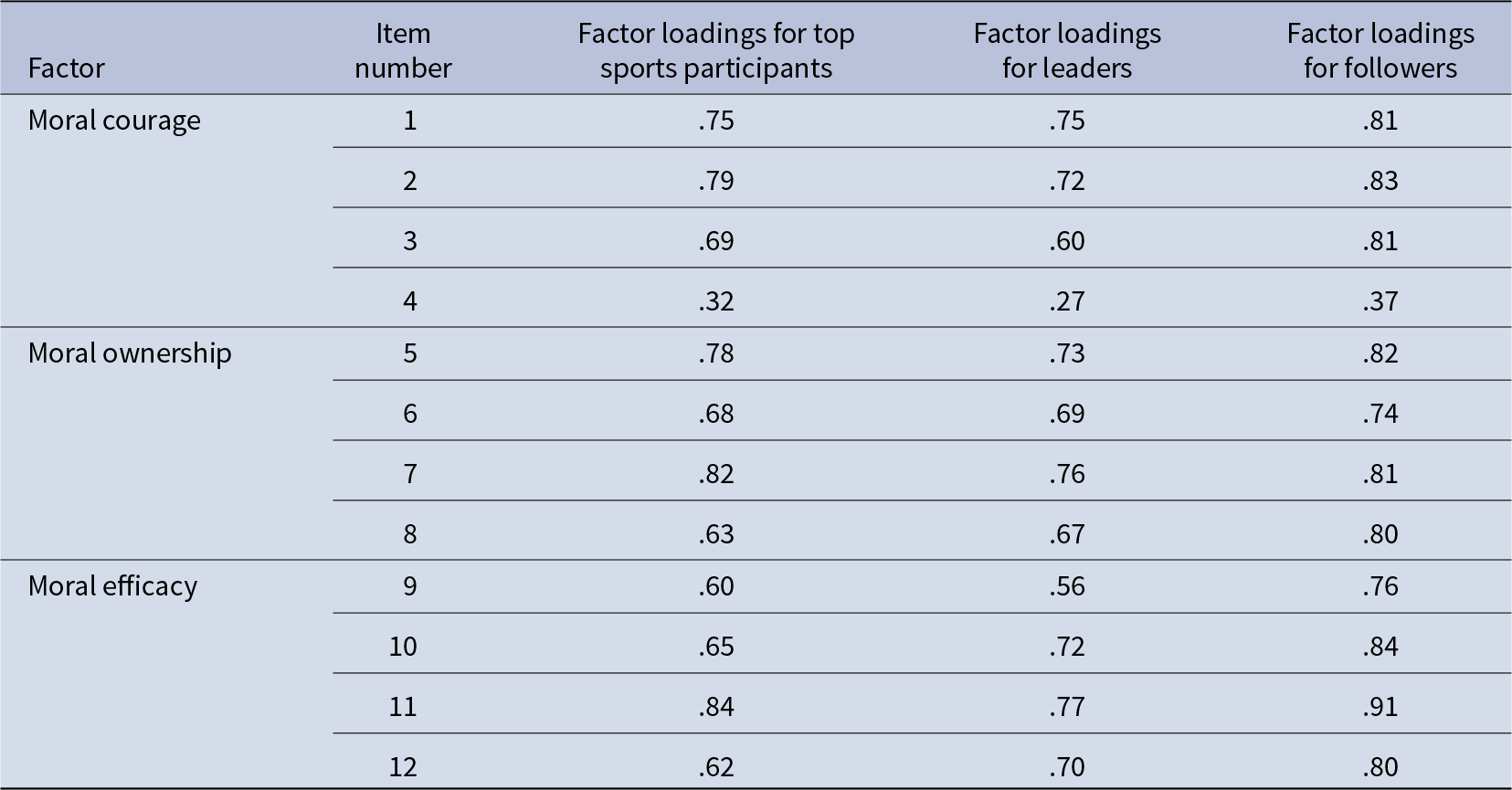
Moral potency profiles
We conducted LPA (Muthén, Reference Muthén, Marcoulides and Schumacker2001) to identify subgroups (i.e., profiles) among the three samples (Top sports, Leaders, and Followers) based on the three dimensions of moral potency. LPA is an exploratory, data-driven method which examines the distributions of groups in the data and determines whether those distributions are meaningful (Ferguson etal., Reference Ferguson, G. Moore and Hull2020). This means that when the number and characteristics of potential profiles or patterns are not predetermined, the LPA enables identifying the best fitting model that is based on how the variables of interest appear in the data. LPA has two main advantages over commonly used traditional cluster analysis. First, LPA is a model-based approach that generates estimates for each individual’s group membership probability. Second, LPA allows for the statistical testing of these models and analyses of their goodness of fit. Thus, LPA can be used to identify the smallest number of latent groups that adequately describe the variation in the observed continuous variables. The mean sum scores of the moral potency dimensions were used to determine the number and composition of the latent profiles, and the dimensions were allowed to correlate with each other.
The appropriate number of latent groups was determined based on robust maximum likelihood estimation method and several statistical criteria (Spurk etal., Reference Spurk, Hirschi, Wang, Valero and Kauffeld2020): log likelihood, entropy value, the adjusted Bayesian information criterion (aBIC), the Lo–Mendell–Rubin adjusted likelihood ratio test (LMR), the Vuong–Lo–Mendell–Rubin likelihood ratio test (VLMR), and the bootstrap likelihood ratio test (BLRT). The smallest log likelihood and low aBIC values indicate the best fitting model. Entropy values range from 0 to 1, where high values indicate that the latent groups are highly discriminative and a value between .70 and .80 is considered to indicate reliable solution. The LMR, VLMR, and BLRT compare solutions with different numbers of latent groups. They provide a p-value that is used to determine if there is a statistically significant improvement in fit after adding one more class. After identifying most appropriate LPA model with the best fit, the latent group probabilities (indicating the most likely profile membership for each individual) were saved. This grouping was then used in SPSS for further statistical analyses.
Table 2 presents the group sizes and fit indices of alternative group solutions of the LPA. The estimation process was terminated after BLRT reached a non-significant p-value (p>.05), which indicated that the point was reached when increasing the number of groups did not improve how well the model fit the data. As seen from the fit indices(Table 2), in samples 1 and 2, the three-group solution was chosen as the best fitting one, whereas in sample 3, the four-group solution was supported. Figures 1–3 show the z-scores of each moral potency dimension within each profile among all three samples.
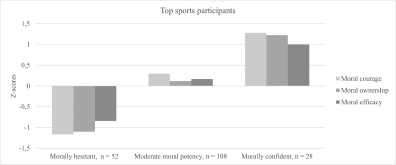
Figure 1. The levels of moral potency dimensions in each identified moral potency profile among the top sports participants.
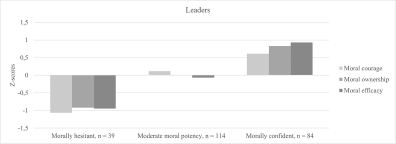
Figure 2. The levels of moral potency dimensions in each identified moral potency profile among the leader participants.
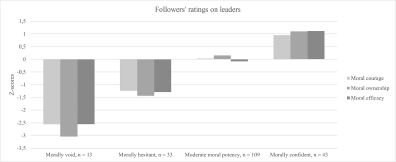
Figure 3. The levels of moral potency dimensions in each identified moral potency profile among the follower participants.
Table 2. Fit indices for the latent profile analysis of moral potency among the three samples
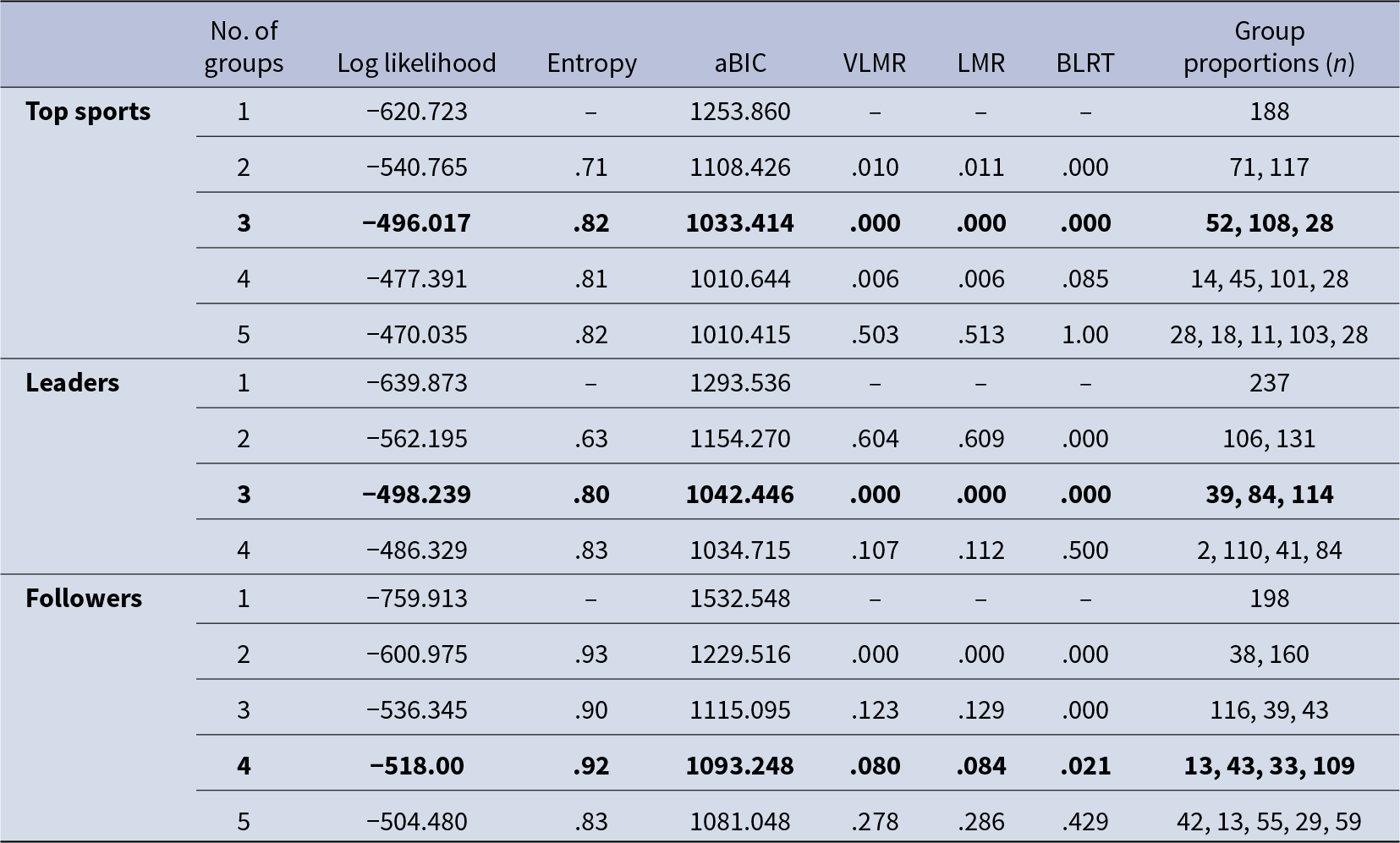
Notes: aBIC=sample-size adjusted Bayesian information criterion, VLMR=Vuong–Lo–Mendell–Rubin test, LMR=Lo–Mendell–Rubin test, BLRT=bootstrap likelihood ratio test.
Bold text indicates the best fitting model solution in each sample.
In all samples (Top sports, Leaders, and Followers), three profiles were clearly identifiable as representing evaluations of moral potency: morally hesitant (n=108, 114, 109), moderate moral potency (n=52, 39, 33), and morally confident (n=28, 114, 43). In each sample, these three profiles captured the qualitative composition of the three moral potency dimensions, which were all on low, moderate, or high level. In addition, a minority group (n=13) was identified among the follower sample, which gave significantly lower evaluations of their leaders’ moral potency compared to the profile ‘morally hesitant’. Because of these low ratings on leader morality, we named this profile as ‘morally void’. This was based on the definition by Kaptein (Reference Kaptein2019), where moral void refers to the absence of a shared and adequate moral orientation in leadership.
Ethical culture evaluations between the moral potency profiles
Next, we used analysis of (co)variance to test the differences in ethical culture evaluations between the profiles within the Top sports and Leader samples. The correlated, eight-factor structure of the CEV scale provided a good fit with the top sports sample: χ2 (456)=909.52, p<.001, RMSEA=.07, SRMR=.05, CFI=.92, TLI=.91. For leaders, the fit was acceptable: χ2 (456)=1074.28, p<.001, RMSEA=.08, SRMR=.06, CFI=.90, TLI=.89. Table 3 shows the correlations between the moral potency dimensions and ethical culture dimensions. Data analysis using the identified profiles within each individual sub-sample showed the general tendency toward giving positive evaluations of the majority of the ethical culture dimensions among those top sports and leader participants who also rated a high level of moral potency for themselves (seeTables4–5). In other words, those participants who were identified into the morally confident moral potency profiles had, on average, the highest ratings on the ethical culture in their organization, whereas the participants in the morally hesitant profiles had the lowest ratings on ethical culture.
Table 3. Correlations between moral potency and ethical culture dimensions among the full sample
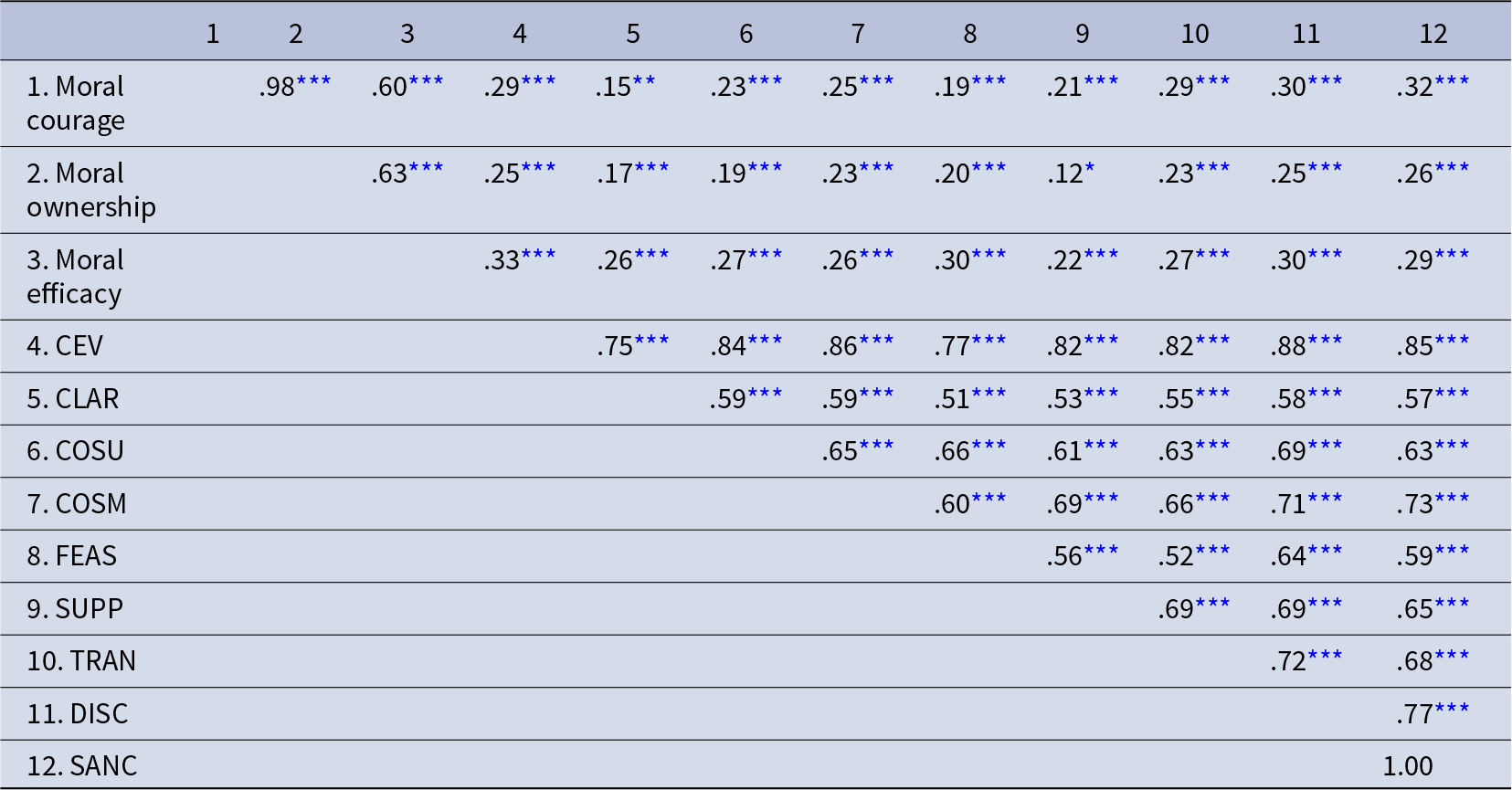
Notes: CEV=Corporate Ethical Virtues (total CEV scale), CLAR=clarity, COSU=congruency of supervisors, COSM=congruency of senior management, FEAS=feasibility, SUPP=supportability, TRAN=transparency, DISC=discussability, SANC=sanctionability.
Pearson correlations,
* p<.05, **p<.01, ***p<.001.
Table 4. Analysis of variance: ethical culture evaluations in different moral potency profiles (top sports)
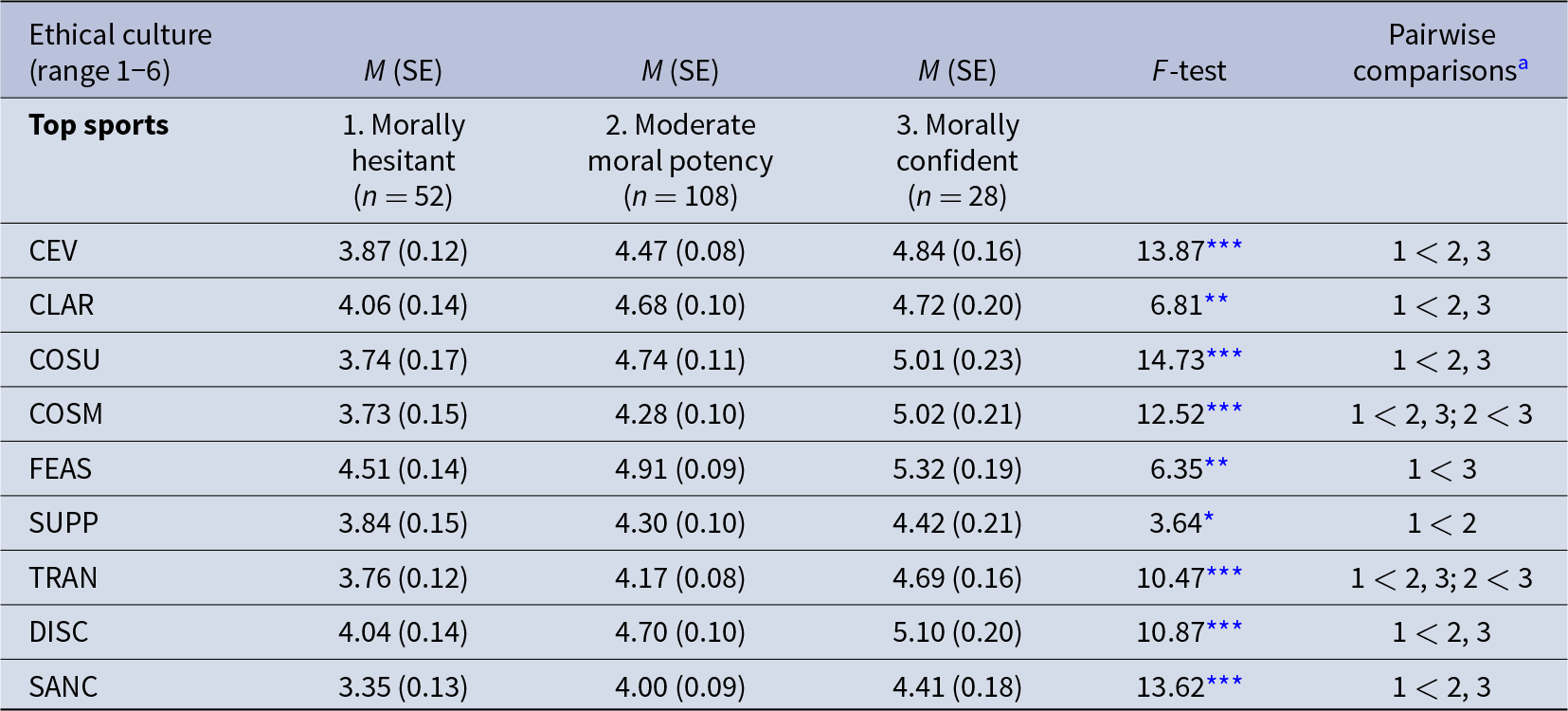
Notes: CEV=Corporate Ethical Virtues (total CEV scale), CLAR=clarity, COSU=congruency of supervisors, COSM=congruency of senior management, FEAS=feasibility, SUPP=supportability, TRAN=transparency, DISC=discussability, SANC=sanctionability.
a LSD comparisons.
* p<.05, **p<.01, ***p<.001.
Table 5. Analysis of variance: ethical culture evaluations in different moral potency profiles (leaders)
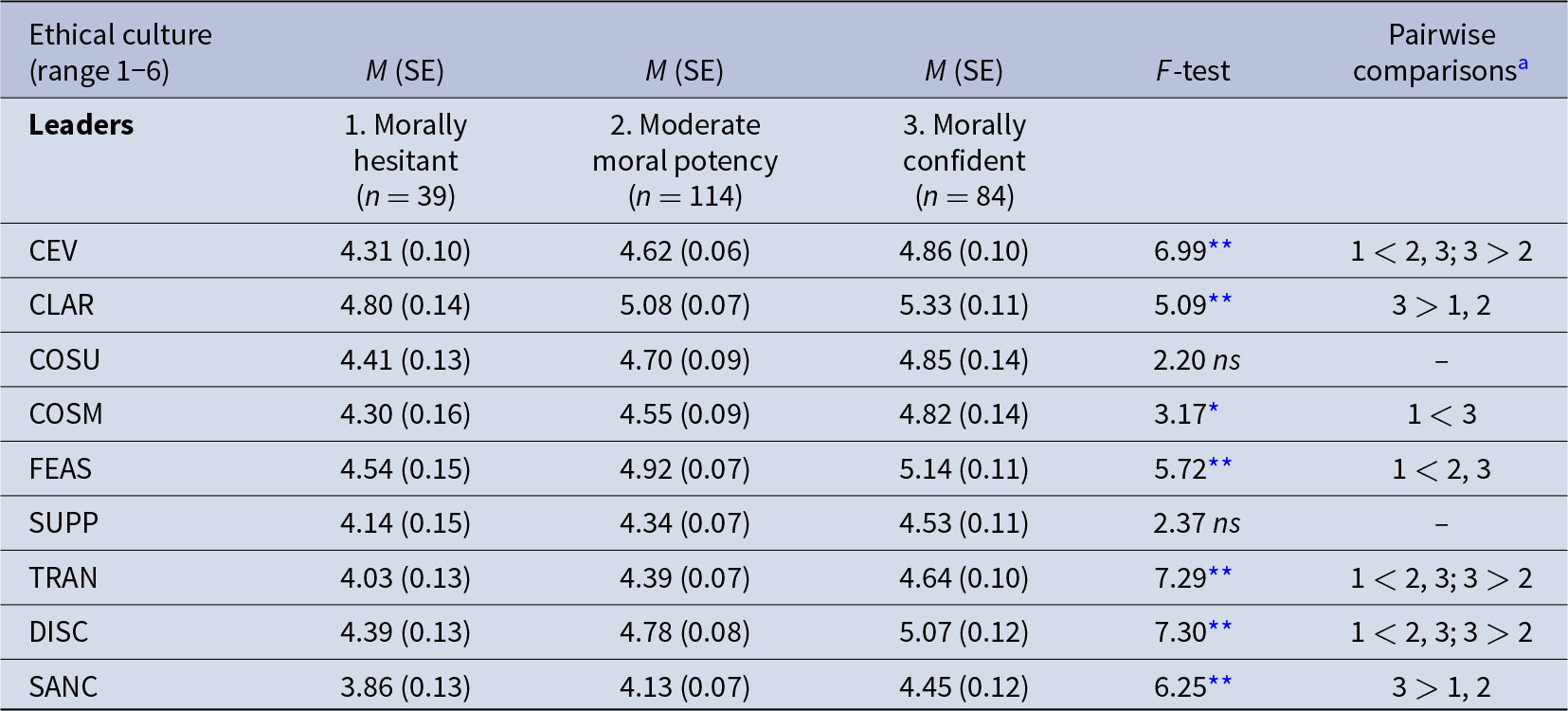
Notes: CEV=Corporate Ethical Virtues (total CEV scale), CLAR=clarity, COSU=congruency of supervisors, COSM=congruency of senior management, FEAS=feasibility, SUPP=supportability, TRAN=transparency, DISC=discussability, SANC=sanctionability.
a LSD comparisons.
* p<.05, **p<.01.
In the last phase, we tested whether evaluations of ethical culture could statistically predict the identified membership in different moral potency profiles by using multinomial logistic regression analysis. We chose the morally confident moral potency profile as our reference group because this profile was similarly identified in all three samples, and it enabled us to identify potential risk factors for belonging to the profiles with less moral potency.
First, among the top sports participants, when compared with the morally confident profile, lower ratings of ethical culture were associated with an increased likelihood of being identified into the morally hesitant profile (β=−0.75, p<.01) and into the moderate moral potency profile (β=−0.68, p<.01). Based on the odds ratios, when ethical culture ratings decreased by one SD, then the participant was more likely to be classified into the morally hesitant profile (OR=0.91, 95% CI: 0.87–0.95) or into the moderate moral potency profile (OR=0.94, 95% CI: 0.90–0.97) than into the morally confident profile.
Second, among leaders, lower ratings of ethical culture were associated with an increased likelihood of being classified into the morally hesitant profile (β=−0.92, p<.01). Based on the odds ratios, when ethical culture ratings decreased by one SD, then the leader was more likely to be identified into the morally hesitant profile (OR=0.40, 95% CI: 0.23–0.69) than into the morally confident profile.
Finally, among the followers, we did not find any significant associations between leader-rated ethical culture and the follower-rated moral potency profiles (p-values of the multinomial logistic regression analysis ranged from .364 to .942). The followers did not give any ethical culture evaluations themselves in this study.
Discussion
Our study employed Hannah and Avolio’s (Reference Hannah and Avolio2010) three-dimensional model of moral potency (comprising moral ownership, moral efficacy, and moral courage) to identify individuals’ moral potency profiles and examine how these profiles are linked with evaluations of ethical culture. We used three distinct samples, allowing the study of moral potency and its associations with ethical culture in diverse contexts – one such context were top sport organizations that were under critical public evaluation regarding their ethical behavior during the time of this study in Finland.
Theoretical and practical implications
We found similar profiles in all three samples: moderate moral potency, morally hesitant, and morally confident. The moderate moral potency was the majority profile in all the samples, whereas the minority profiles were morally confident in the Top sports sample and morally hesitant among the leaders. In addition, a fourth moral potency profile was identified among the follower sample, in which they evaluated their leaders’ moral potency to be very low, named as morally void. Moral void describes a lack of or an inadequate level of morality (Kaptein, Reference Kaptein2019), and here it referred to the followers’ perceptions of their leader as lacking moral potency. Although the identified moral potency profiles were similar across the different samples, the small, atypical profiles (the morally hesitant and morally void) would not been detected with a traditional variable-centered research design. Thus, our findings bring theoretical contribution on the different combinations and levels of moral potency dimensions in different contexts (representing top sports and leadership). The findings indicate that if researchers wish to capture also the smaller nuances of moral potency, they should go beyond mean level scores and consider applying person-centered study designs.
In addition, the three moral potency dimensions showed parallel patterns in each sub-sample. For example, we did not identify any profiles which would have a combination of high level of moral courage but low levels of moral ownership and moral efficacy. Instead, all three dimensions had similar mean levels within each identified profile, that is; very low, low, moderate, or high. Thus, in line with the original conceptualization and theory by Hannah and Avolio (Reference Hannah and Avolio2010), all three components of moral potency are necessary and not sufficient on their own; they can be seen as individual dimensions, but they correlate with one another and together constitute the overall strength of moral potency.
We also found that the followers were somewhat more critical in evaluating their leaders’ moral potency than the leaders themselves. This important finding highlights the value of including other-rated indicators when examining moral actions and moral leadership within organizations. Using self-reports alone can produce favorably biased results; social desirability or personal ‘moral blind spots’ may lead to overly positive self-ratings. This is in line with previous findings on moral overconfidence, which have demonstrated that people tend to be overconfident about themselves especially in the workplace (Meikle, Tenney, & Moore, Reference Meikle, Tenney and Moore2016). These kinds of inflated self-perceptions can be even more pronounced in the moral domain because the criteria for evaluating moral abilities can be more subjective than other (e.g., intellectual) abilities (see Smith & Kouchaki, Reference Smith and Kouchaki2021). To summarize, our study suggests that using multi-rater research designs can provide more accurate representations of leadership-related phenomena in the moral domain compared to using only self-evaluations. In addition, using multisource feedback could be useful in leader development programs that aim to increase leaders’ self-perception accuracy (for a review, see Fleenor etal., Reference Fleenor, Smither, Atwater, Braddy and Sturm2010).
Our findings contribute to the literature on (un)ethical behavior in organizations (see Schwartz, Reference Schwartz2016; Treviño etal., Reference Treviño, Den Nieuwenboer and Kish-Gephart2014) as we found that the strength of ethical culture associated with the different moral potency profiles. Both the top sports and leader participants who were identified into the morally confident moral potency profile gave the highest evaluations of the ethical culture in their organization, whereas those who were classified into the morally hesitant profile gave the lowest evaluations of ethical culture. In particular, low evaluations of ethical culture increased the likelihood of belonging to the morally hesitant and moderate moral potency profiles among top sports respondents and to the morally hesitant profile among leader respondents. Thus, in line with the social norm theory (Cialdini & Goldstein, Reference Cialdini and Goldstein2004; Cialdini & Trost, Reference Cialdini, Trost, Gilbert, Fiske and Lindzey1998), the strength of ethical virtues in the organization could be significant in setting positive social norms that enforce personal moral potency. This is also in line with the previous finding by Gok etal. (Reference Gok, Babalola, Lakshman, Sumanth, Vo, Decoster and Coşkun2023).
Finally, our findings showed that the participants from top sports organizations gave similar evaluations of moral potency and of ethical culture compared to the two other samples (leaders and followers), even when significant negative publicity occurred toward top sport unethical actions during the data collection in Finland. This might be attributable to the participants’ strong identification to their own organization (see Conroy, Henle, Shore, & Stelman, Reference Conroy, Henle, Shore and Stelman2017), which may act as a counter-mechanism resulting in a higher sense of organizational ethicality despite public accusations of unethical behavior. In addition, employees may not always recognize the types of incidents that would require them to behave with moral courage (i.e., to stop or question unethical behavior in the workplace). These blind spots, such as accepting organizational behaviors without questioning them, may allow employees to maintain their self-worth as a moral person (Vadera & Pratt, Reference Vadera and Pratt2013). Moreover, those who strongly identify with their organizations can be more vulnerable to experiencing events as identity-threatening, which, in turn, can lead to a heightened probability of engaging in collective lies and turning a blind eye to organizational threats (Leavitt & Sluss, Reference Leavitt and Sluss2015). These are potential, theory-derived explanations that should be investigated in more detail in the future.
Limitations of the study and suggestions for future directions
Our data were collected prior to the COVID-19 era and are thus a reflection of more traditional work settings before the onset of globalized remote work and sudden external ruptures to organizational cultures. Future research could investigate how moral potency and ethical culture are experienced in organizations where employees mostly work remotely. Such research could also advance the understanding of how moral potency is observed and/or expressed in socially visible/invisible situations in office/remote work contexts.
The data were collected only from Finnish organizations, highlighting moral potency in one national context. Thus, more empirical studies are still needed in more diverse cultural and societal contexts. Nevertheless, this study has answered the call of previous studies to investigate moral potency in broader settings, as we focused on two very different contexts of work: top sports and leadership. Also, the three diverse samples complemented one another, and especially using the follower ratings in addition to leaders’ self-evaluations of moral potency increased the incremental validity of the findings. Unfortunately, we were not able to control for potential selectiveness of the follower sample, which means that the leaders could have invited those followers to participate who they thought would give positive ratings on their morality. Thus, if the follower evaluations were partly biased, it is possible that the actual percentage of employees who felt they had a ‘morally void’ leader could be even larger. Future studies should therefore aim toward more independent follower sampling when using multisource data.
Our cross-sectional study design can also be considered a limitation. In the future, more studies are needed on the longitudinal associations between moral potency and ethical culture. For example, are there significant differences between the separate virtues that comprise ethical culture, and how do these virtues predict moral potency over time? This could help to understand which virtues are especially important in supporting moral potency in organizations in the long run, or vice versa, whether the lack of certain virtues is an especial threat for hindering moral potency.
Conclusions
Based on our findings, when investigating how moral potency appears among individuals in organizations, all three components – moral courage, ownership, and efficacy – should be evaluated simultaneously. They are individual dimensions, but together they constitute the overall strength of moral potency. When the focus is more specifically on leaders and their moral potency, follower ratings should be included in addition to leaders’ self-evaluations. This will give a more balanced understanding of what kinds of moral behaviors the leaders engage in that are also visible to their followers. Finally, as ethical culture and moral potency were found to be intertwined (the stronger the ethical culture, the higher the evaluations on moral potency), it is likely that embedding ethical virtues in organizations can support social norms and social learning, which develops moral potency. This helps both employees and leaders to have both the motivation and agency to act in a morally responsible manner.
Acknowledgements
This paper is based on research projects supported by the Ministry of Education and Culture (grants OKM/25/626/2022 and OKM/78/626/2015) and by the Finnish Work Environment Fund (grants #110104 and #108124).
Conflicts of interest
The authors declare none.
Mari Herttalampi, PhD in psychology, works as a senior lecturer and researcher in the Department of Psychology, University of Jyväskylä, Finland. Her research interests include work and organizational psychology, especially focusing on organizational structures, ethical strain, and their associations with occupational well-being.
Elina Riivari D.Sc. (Econ.) is a University Teacher in Management and Leadership at the University of Open University. Her research interests include ethics and innovation in organizations. Her research has been published in high-quality academic journals and in edited volumes by prestigious publishers.
Marjo Siltaoja is an associate professor of management at the Jyväskylä University School of Business and Economics (JSBE). Her research focuses on corporate (ir)responsibility, sustainability, and social evaluation of organizational practices. Her work has been published in several management, organization, and business ethics journals.
Taru Feldt is a professor of work and organizational psychology. She has studied the well-being of different occupational groups through longitudinal studies. In particular, she has focused on managers’ well-being from the perspective of sustainable careers. In recent years, her research has also focused on the intensification of working life and its association with employee well-being in healthcare.









